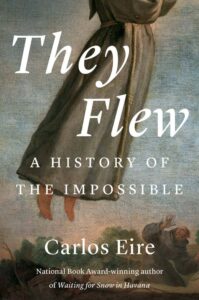
What We’re Reading: They Flew
They Flew: A History of the Impossible
Carlos Eire, Ph.D.
Yale University Press 2023
What is impossible? And, perhaps more to the point, who decides?
During a tour of St. Teresa of Avila’s convent in Spain in the 1980s, the tour guide casually observed that the group had reached the room where “St. Teresa and St. John of the Cross levitated together for the first time.” The information was presented as a simple fact. The author, Carlos Eire, a visitor on the tour, was struck: how could levitation be presented as fact? And so Eire began a decades-long investigation into the history of the impossible.
In They Flew Eire scrutinizes events that most of us would deem impossible. St. Teresa of Avila, St. Joseph of Cupertino, and María de Ágreda defied the limits of the possible, according to our sensibilities. Their stories, along with those of other saints and frauds and witches from 16th and 17th-century Europe, provide the context for Eire’s exploration. The early modern period was the beginning of the so-called “Age of Reason,” when science and empiricism rose to new heights and began to transcend the “superstition” of the Middle Ages. It was the period during which newly divided Roman Catholics and Protestants fought for supremacy and the period in which the boundary between the natural and the supernatural was gradually redrawn.
In They Flew Eire scrutinizes events that most of us would deem impossible.
Each part of They Flew examines “impossible” events and beliefs and demonstrates the permeability of the boundary between nature and the supernatural during the early modern period. Part one of the book covers the surprisingly long, worldwide history of levitation and then analyzes evidence for two dramatic early modern levitators: St. Teresa of Avila and St. Joseph of Cupertino. Part two provides an historical overview of bilocation followed by an analysis of well-known bilocator, María de Ágreda, another Spanish nun who became known in the Americas as the Lady in Blue.

Part three introduces some surprisingly common ground: the work of the devil. People on all sides comfortably accused the devil of disturbing the natural world. Catholics discerned whether the source of the disturbance was God’s beneficence or the devil’s malevolence. Protestants, who believed that miracles ceased after the Apostolic age, assumed that the devil was behind all of it. The mix resulted in a relentless search for the devil and his minions, and ultimately, in an impossibly lengthy period of witch trials.
Throughout the book Eire skillfully evaluates evidence. He scrutinizes early modern sources — eyewitness accounts, court testimonies, written accounts — and current interpretations of those sources, which attribute the impossible to strictly materialist causes. He notes that many of the stories have had a remarkably long shelf life — so long that a 20th-century tour guide in Avila, Spain thinks nothing of presenting St. Teresa’s levitations as fact.
As a good historian, Eire concedes that at this distance in time, with the evidence available, we cannot know that St. Teresa flew or María of Ágreda bilocated, although we know that many of their contemporaries — from right across the social spectrum — believed they flew and bilocated and did all sorts of impossible things. And so, Eire introduces Emile Durkheim’s concept of a “social fact” — a collective worldview in any given society that delineates what is possible or impossible, and that obliges people in the cauldron of the same culture to believe the same kinds of things about nature and the supernatural. The period covered in They Flew proved to be a transitional time, a time in which societal beliefs in the impossibility of any given event began to change and during which people attributed events simultaneously to either — or both — nature or the supernatural.
We live in a time after that change, a time post-Enlightenment and post-modern, a time in which the boundary between nature and the supernatural has been so firmly fixed as to include in the realm of believable only what can be verified by empirical evidence. The impossible is believed to be, well, impossible. And perhaps that is the social fact of our time.
They Flew is what historians call a “big book” — an important work that questions the way historical sources are interpreted or changes the questions asked of the past. Carlos Eire does both, which perhaps will cause us to question our own assumptions, our own worldview. Perhaps it will begin another chapter in the history of the impossible.
Carlos Eire, T. Lawrason Riggs Professor of History and Religious Studies at Yale University and an IACS Affiliated Scholar, completed a “Scholar Q&A” for the IACS blog about his vocation as a historian, what has changed and what has stayed the same about belief over the last 500 years, and how to understand “facts” and “reality.”
Professor Eire’s next project is an extended essay on the centrality of paradox and of belief in the supernatural in the Catholic intellectual tradition.